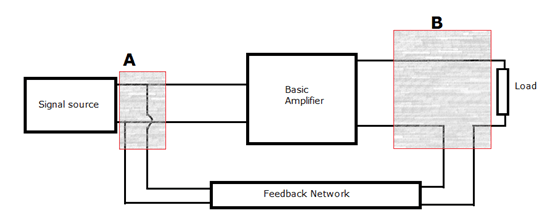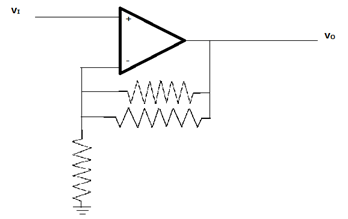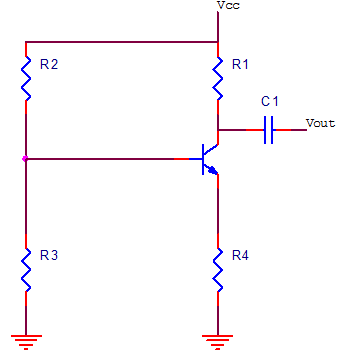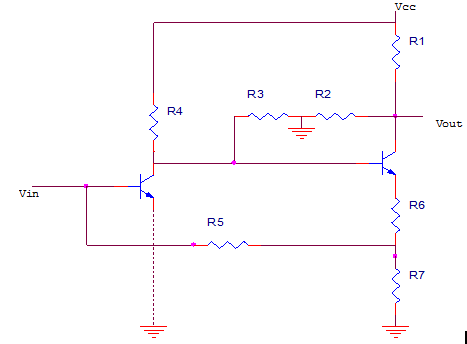This set of Analog Circuits Multiple Choice Questions & Answers (MCQs) focuses on “Feedback Connection Types”.
1. Which of these doesn’t refer to a series-shunt feedback?
a) Voltage in and Voltage out
b) Current in and Voltage out
c) Voltage Controlled Voltage Source
d) Series voltage feedback
View Answer
Explanation: In a series shunt feedback network, feedback is connected in series with signal source but in shunt with the load. Error voltage from feedback network is in series with the input. Voltage fed back from output is proportional to output voltage, hence parallel or shunt connected. The current in and voltage out connection refers to a shunt-shunt connection.
2. In the following diagram, shaded portions are named A and B.

What are A and B?
a) A = Current sampling network, B = Voltage sampling network
b) A = Current mixing network, B = Voltage sampling network
c) A = Shunt mixing network, B = Current sampling network
d) A = Voltage mixing network, B = Current sampling network
View Answer
Explanation: When feedback network is in shunt with load, then output voltage appears as input to feedback. In above case, output current appears as the feedback input, hence B is a current sampling network. Also, feedback network is in shunt with the signal source, hence it’s called shunt mixing or current mixing.
3. Given that a feedback network is shunt-series, and output load is 10kΩ, what is the output voltage across it given that transfer gain is 10, source current is 20mA and feedback current is 10mA?
a) 1V
b) 2V
c) 10V
d) 20V
View Answer
Explanation: RL = 10kΩ
IF = βIL
IL = IF/β = 10/10 = 1mA
VL = ILRL = 10V.
4. Consider the circuit shown.

What is the type of sampling observed?
a) Shunt-Series feedback
b) Series-Series feedback
c) Shunt-Shunt feedback
d) Series-Shunt feedback
View Answer
Explanation: The feedback network is connected directly to output node, so voltage sampling occurs. However, it’s not connected directly to the input node. Hence it’s series mixing at the input. Voltage sampling is a shunt network.
5. Consider a voltage series feedback network, where amplifier gain = 100, feedback factor = 5. For the basic amplifier, input voltage = 4V, input current=2mA. Find the input resistance of the network.
a) 1.002kΩ
b) 1002kΩ
c) 2kΩ
d) 2000kΩ
View Answer
Explanation: RI = VI/II = 4/2m = 2kΩ
RIF = RI(1+A.β) = 2k(1+500) = 1002kΩ.
6. In which network is the unit of the feedback factor Ω?
a) Shunt-shunt feedback
b) Shunt-series feedback
c) Series-series feedback
d) Series-shunt feedback
View Answer
Explanation: In series-series feedback, the output is current sampled, that is it is in series with the load. Also, input is a voltage mixer, which is in series with signal source. So feedback factor
Β = VF/IL in Ohms.
7. A circuit can have more than one type of feedback.
a) True
b) False
View Answer
Explanation: In any circuit, the feedback depends on the configuration of resistor network and presence of capacitances. Consider a collector to base bias circuit, in which base resistance causes voltage shunt feedback. However, presence of an emitter resistance provides a second feedback of current series type.
8. Consider given circuit.

What is the feedback configuration?
a) Current series feedback
b) Current shunt feedback
c) Voltage series feedback
d) Voltage shunt feedback
View Answer
Explanation: The resistance R4 is the feedback network resistance. There is no bypass capacitor being used. The resistance is not directly connected to either the input node or output node. Hence it’s a current series feedback.
9. Consider the circuit shown below.

Consider A: Current-shunt feedback
B: Current-series feedback
C: Voltage-shunt feedback
D: Voltage-series feedback
Which of the above are present?
a) A and B
b) A only
c) B only
d) A and D
View Answer
Explanation: Resistor R5 causes global feedback. It is connected to the input node, causing shunt mixing but not to output node, meaning current sampling. Hence it’s a current shunt feedback. Resistors R6 and R7 are neither connected to input nor the output, causing series mixing and current sampling, hence causing current series feedback.
10. In a feedback network, input voltage is 14V, feedback voltage is 6V and source voltage is 20V. β is in ohms. What is its configuration?
a) Shunt-Shunt feedback
b) Shunt-Series feedback
c) Series-Series feedback
d) Series-Shunt feedback
View Answer
Explanation: Given that input is 14V, feedback is 6V and source is 20 V, we can see
VI = VS – VF, which is voltage mixing. Also, β is in ohms that is voltage/current. Since output of feedback is voltage and input is current, the output has current sampling. Thus, configuration is a series-series feedback/current – series feedback.
Sanfoundry Global Education & Learning Series – Analog Circuits.
To practice all areas of Analog Circuits, here is complete set of 1000+ Multiple Choice Questions and Answers.
If you find a mistake in question / option / answer, kindly take a screenshot and email to [email protected]
- Apply for Electrical Engineering Internship
- Check Electrical & Electronics Engineering Books
- Apply for Electrical & Electronics Engineering Internship
- Practice Electrical Engineering MCQs
- Practice Electrical & Electronics Engineering MCQs
